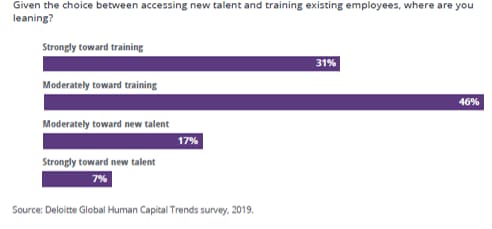Insight

Driving the upskilling and reskilling narrative
Why is Learning & Development departments not driving the upskilling and reskilling narrative?
Organizations are increasingly recognizing the importance of reskilling and upskilling, but are not reaping the full potential of their investments yet. To achieve success, HR and Learning & Development departments must take a leading role and drive the narrative around upskilling and reskilling.
Skills of the Future
In times of continuous change, the capacity to learn and evolve is the key to staying successful as an organization and as an employee. With the rapid pace of technological changes, combined with a changing nature of the workforce, more organizations are asking themselves the question: ‘Which skills do we need to be equipped for the future?’. Organizations need to address the challenge of upskilling and reskilling their workforce, not only to survive, but to thrive. According to the Future of Jobs report of the World Economic Forum 2018, 42 percent of employees will be confronted with a shift in the required skills between 2018 and 2022. Deloitte’s Human Capital Trends report of 2019 shows that 86 percent of respondents indicate that the way employees learn should be approached in a new way. On the other hand, only 10 percent of organizations say they are prepared for this.
Deloitte’s Human Capital Trends report is the largest longitudinal study on Human Capital issues, which has over 10.000 respondents across 119 countries and gives a solid insight in what is happening globally. The 2019 Human Capital Trends Report focuses on the human element in reinventing with a human focus, realizing that in an age of technology the ultimate differentiator is going to be the people. The rise of robotics and automation are not the only disruptors forcing organizations to rethink how they skill and upskill their employees on a large scale. Demographical disruptions like employing five generations of workers, the gig-workforce and the 50+ year career requires fundamentally rethinking how to source, develop and nurture desired skills in the organization.
While organizations are increasingly recognizing the importance of reskilling and upskilling, and are generally also prepared to invest in it, companies are not reaping the full potential of their investments yet. In an age where we have seen some of the most high-tech advancements to date, according to research done by MIT, productivity gains during the 4th industrial revolution are lagging behind expected productivity predictions. MIT reports a flattening of productivity despite the technological advancements. It emphasizes that we cannot expect that the implementation of new learning technology alone is going to tip the scale when it comes to upskilling and reskilling, instead we advocate for a cross-siloed approach to define the desired outcomes and to orchestrate a cohesive plan to deliver value for the organization through upskilling and reskilling initiatives.

How to define the upskilling and reskilling narrative:
- Zoom out, Zoom in
With the business, HR and Learning & Development departments should take a step back. The business strategy and vision set the path for where to play, which will be the guiding posts to imagine the possibilities of how learning initiatives can be composed in a way that increases both value and meaning for the organization. To then zoom in and identify the capabilities and skills which are required to push the envelope for the organization.
- Redefine the learning ecosystem
Make learning more effective and valuable to the organization, most organizations focus on implementing a new learning technology platform. Hoping that the technology will support in upskilling their employees by bringing just-in-time and on demand learning at their fingertips. While the infrastructure is an important vehicle in delivering learning, we predict that technology will not deliver on that promise on its own. Deploying the technology platform without rethinking why, how and what learning is delivered will not promote learning nor improve learning outcomes.
Achieve truly impactful learning in the 4th Industrial Revolution, organizations should prioritize bringing the learning ecosystem in line with their learning strategy. Having an overview of the learning landscape, enables organizations to define gaps in offerings during the moments of need and build on that to make learning more immersive and personalized.
- Skill, up-skill and re-skill again
The light of increased automation, Artificial Intelligence (AI) and robotics, the changes to the work that needs to be delivered by the workforce will continue to change. This makes upskilling and reskilling not a one-time exercise, but a permanent assignment. Successful organizations will be able to learn fast and are able to replicate it effectively for their entire workforce. Disruptors are changing jobs, skills are decreasing in value faster than ever and employee tenure is 4.5yrs on average. This applies to the hard-technical capabilities in areas such as programming and data research but also to enduring human capabilities such as curiosity, creativity and empathy. Successful organizations will be able to put into place the foundational elements to nurture and grow the desired human capabilities and skillsets.
Learning & development driving the skills narrative
Investing in upskilling and reskilling should be a priority for organizations to ensure they have the right skills and capabilities in place to proactively address potential disruptors. Their people will have the mindsets and agility required to thrive in an environment of constant disruption. Learning has a crucial role to play through culture and technology. If orchestrated well, this increased focus in learning and development will have numerous positive spillover effects and can work as a catalyst of addressing the questions of purpose, meaning and culture for the organization as well as individuals.
Learning and development in the 4th Industrial revolution is no longer the exclusive domain of a select group of learning professionals, it is a key strategic differentiator to drive growth and value. Together HR and Learning & Development, are uniquely positioned to help their business define the cross-silo narrative to support the upskilling and reskilling narrative, however we often see that HR and Learning & Development departments are not involved in the upskilling and reskilling conversations.
Our challenge to HR and Learning & Development departments is: take that role, become a master in the continuous sharpening of skills and help your organization to become and remain a learning organization.
There is an opportunity for Learning & Development to drive the narrative around upskilling and reskilling within the business and to rethink the foundational organizational structures that nurture the desired capabilities and to ultimately define and provide the conditions to truly unleash the workforce and maximize human potential.

